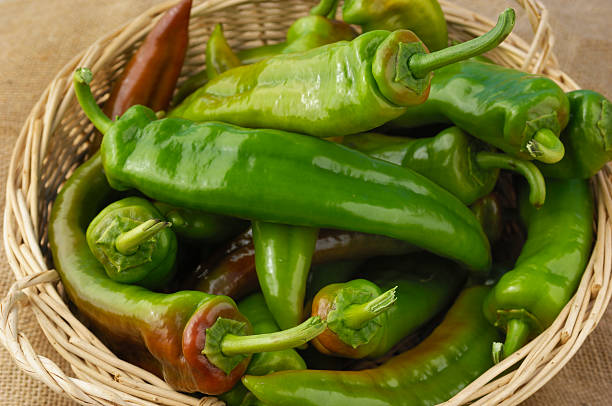Anaheim pepper is a super delicious, mild, and versatile Mexican chili perfect for giving a light fruity kick to the recipes. People who are not crazy fans of spicy foods love these chiles incredibly.
Whether they are stuffed, stir-fried, Grilled, or canned, Anaheim peppers are always irresistible. Their milder heat also makes them perfect for topping, salads, sauces, salsas, and even raw eating.
Want to know the best ways of cooking Anaheim peppers or looking for a suitable Anaheim pepper substitute, here what you should know. And, if you have this workhorse on hand, know different ways of using Anaheim pepper uniquely.
What Is An Anaheim Pepper?
Anaheim pepper is a medium-sized green pod with smooth waxy skin and looks quite similar to habanero pepper. However, this similarity is only limited to the appearance because they offer a vastly different flavor profile to their respective food dishes.
The crunchy fruity flesh is what makes it different from other typical chiles. It adds umami richness to soups, stews, and sauces with a slight savory spicy kick which stimulates the taste buds moderately. It can turn the overall bland recipe into a flavorful treat.
Green pods are mostly used for cooking and baking however these can also ripe into dark red pods which are common as Mexican Chiles. These ripen Anaheim peppers are the mainstay of a variety of American and Mexican cuisines as well as salsas, soups, stews, sauces, and Tex Mex paste.
How Are Anaheim Peppers Different From Other Mexican Chiles?
Anaheim pepper is a different cultivar from its other Mexican cousins like habanero, Pasilla, ancho, and jalapeno peppers. It grows up to 5 inches with a conical curvature and tapering ends.
When green, the chili skin is smoother, waxy, and has a glossy shine. Inside is a pale green fruity flesh around so many light-colored seeds. When tasted raw, Anaheim pepper offers slight crisp and crunchy consistency. When remain on vines, it turns into wrinkled red Mexican chili more like Pasilla, and ancho chiles.
Both red and green forms are equally welcomed in home kitchens and restaurants for flavoring so many traditional cuisines, soups, and salads.
What Does Anaheim Pepper Taste Like?
When raw, Anaheim peppers offer an amazing blend of fruity and peppery flavor to each bite. These are also crunchy when chewed raw with a moderate spice level which doesn’t linger on the palate.
When cooked or sauteed, these Mexican spices develop a significant smoky and tangy flavor with a subtle fruity sweetness. When remain on the vine, Anaheim peppers ripe and turn into red chiles with appearance more like traditional red peppers. However, their pronounced fruity flavor always makes a difference between Anaheim pepper and other Mexican chiles.
Anaheim Pepper Substitute
It is quite obvious now that Anaheim Chili is a versatile spice used as a flavoring agent in a number of cuisines and savory treats. However, what if one cannot get these peppers locally or if they are simply out of season?
What should be the best substitute for Anaheim pepper you can get on hands easily without sacrificing the real flavor of the recipe. Here are some closer alternatives you can use instead of Anaheim peppers.
1. Bell Pepper
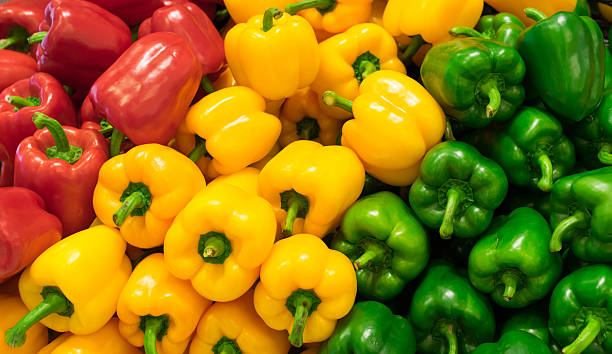
Although not similar to look at, bell pepper is a great alternative to Anaheim chili. It’s a really good way of adding a peppery flavor to dishes without boosting the heat of the food. Bell pepper is readily available throughout the year so you can get it any time when Anaheim pepper gets short.
They can be cooked in various ways but are perfect for stuffing and stir-frying. They are available in green, red, and yellow color and thus add a satisfying color pop to recipes. Always remember, bell peppers have no heat so you have to use other peppers for significant heat to taste.
2. Guajillo Chilli
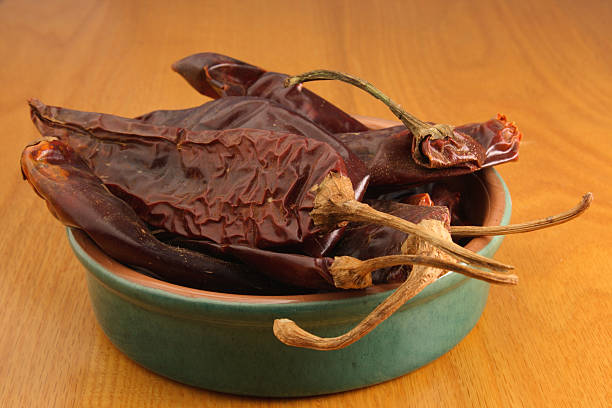
Guajillo chilli is another comparable substitute for Anaheim pepper you can get on hands easily. It resembles Anaheim pepper in many ways such as they look similar, have a similarly sweet, fruity, and smoky flavor with a closely related spice level.
The best ways of using guajillo chilli are roasting, baking, or tossing them in soups, sauces, stews, and casseroles. However, guajillo peppers are not suitable for raw eating in salads because they are hotter than Anaheim peppers and can stimulate the palate noticeably.
3. Poblano Chiles
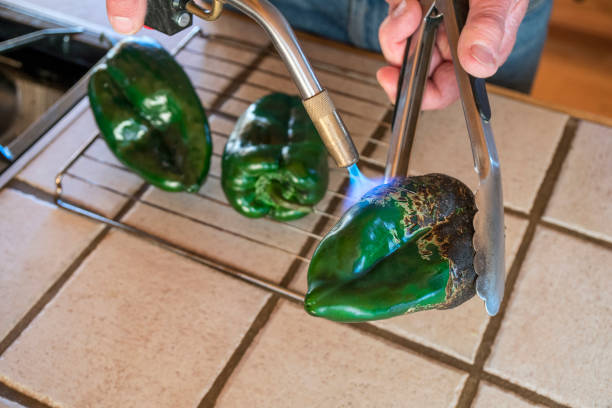
Poblano pepper would surely be your best bet as they are closest to Anaheim Chiles in terms of heat and spice level. The relatively thicker pepper skin of poblano makes it an excellent pepper for stuffing and roasting. You can also toss it into sauces, salsas, and soups as these can withstand prolonged cooking and simmer very well. Green poblano peppers are usually used for cooking but you can also incorporate red poblano Chiles into sauces and salsas.
4. Ancho Peppers
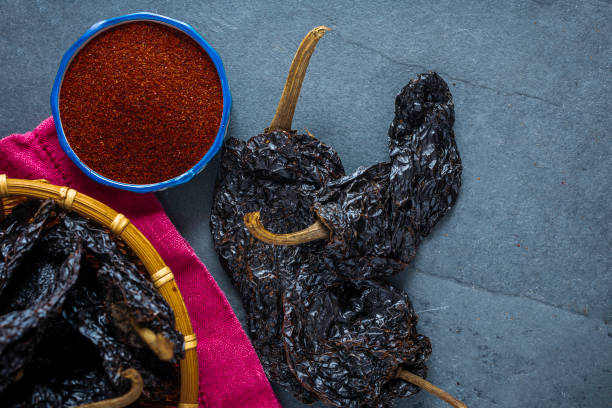
Perfect chili for sauces, marinades, and side dishes, ancho pepper is also a Mexican chili. It is the best Anaheim pepper substitute as it has a moderate spice level, subtle sweet peppery flavor with a slight crisp in every bite similar to Anaheim Chiles.
They are also widely available in powder form as well as whole or pureed form. You can pick anyone according to your recipe preference. When cooked ancho peppers develop a significant smoky aroma and flavor which is comparable to Anaheim. So, if you are looking for pepper as similar as Anaheim, go for ancho peppers.
Read also: Spanish Onion: Here’s How to Substitute, Buy, And Store
How Hot Is An Anaheim Pepper?
Everyone knows that Anaheim peppers are popular for their mild spicy flavor and heat level. But you must know how hot it is to make a comparison of Anaheim with other Mexican peppers.
Anaheim peppers range from 500 to 2500 Scoville Heat units which are quite lower and probably one-half of the jalapenos heat units. Therefore, you can find Anaheim pepper on the lower end and a bit above on bell peppers on the Scoville Heat scale.
Other peppers lie in this range are poblano pepper, ancho chili, Rocotillo Chiles, pardon pepper, cascabel, and black Hungarian peppers. So, you can also use them to substitute Anaheim peppers in your food with a matchable flavor profile.
Cooking With Anaheim Pepper
Anaheim peppers are so versatile workhorse when come to cooking and preserving. Roasting is one of the best cooking ways for Anaheim pepper until their glossy skin is charred. Other methods include sauteing, grilling, stuffing, stir-frying, and deep frying.
After sauteing or stir-frying, slice the pepper in egg-based dishes, sauces, salsas, or chop it to add into salads. Toss these peppers over meat dishes or make a perfect eye-catching topping of pasta, nachos, and pizza.
Besides, stuffing is also a great way of enjoying the fruity flesh of Anaheim peppers without going so spicy and hot. Stuffed them with an old cheese, dip them in an egg and fry until the skin becomes light brown and serve with a side sauce. Cooked Anaheim Chiles pair well with pork, eggs, great northern beans, and rice.
Popular Anaheim Pepper Recipes
If you are a fan of Anaheim peppers, you’ll love these savory treats containing Anaheim as a mainstay ingredient.
- Roasted Anaheim peppers
- Cheese stuffed Anaheim chiles
- Anaheim pepper salsa
- Deep-fried Anaheim chiles
- Chicken and cheese stuffed Anaheim peppers
- Anaheim pepper enchilada
You can also try these recipes using chili of your choice either hotter than Anaheim peppers or even milder such as bell peppers. It’s up to you whether you are craving something really hot to linger on the palate or something really gentle to the tongue.
You may also Like: Kashmiri Chili Powder Substitute
How To Store Anaheim Peppers For Longer?
The whole dried or canned Anaheim peppers remains fresh and usable for up to one year and even more, if sealed properly in an air-tight container. Make sure the container is placed away from the direct sunlight or in a dark and cool place.
However, if you have a lot more Anaheim chiles in your own garden, preserve them after cooking or drying. Preparing salsas, enchiladas, and sauces are the best ways of preserving these versatile peppers.
Besides, canning them in a glass jar or keeping them in the refrigerator is also a good way to make them last longer. Fresh green pods remain fresh for 3 to 4 days at room temperature in the pantry. However, refrigeration can keep them fresh for a week.
Where To Buy?
Anaheim peppers are so versatile and popular among people that you can easily get them from local grocery stores and supermarkets. Go to the chili aisle and find your workhorse placed probably right into the poblano, serrano, jalapeno, and ancho peppers.
However, check them properly before buying them if they are bruised, wrinkled, or fainted in color. Buy only fresh, firm, uniformly-colored green pods with their characteristic glossy shine.
You can also get these peppers online to save your time without compromising the quality.
If you have your own Anaheim peppers in the garden, harvest them when they reached up to 5 to 6 inches. Try to cut these peppers along with their short stem which will ultimately make them fresh and last longer.
FAQs
Can Jalapenos Substitute Anaheim Pepper?
Jalapeno can substitute Anaheim pepper when you crave a similar flavor with a bit higher spiciness as compared to Anaheim. When green, jalapenos are considerably hotter than Anaheim peppers probably double in heat Scoville units, so avoid using them.
When jalapenos ripe on the vine, they develop a milder sweet flavor comparable to Anaheim, so this is what compliments your recipes more instead of Anaheim and other milder peppers.
Jalapenos go well in soups, stews, sauces, and salsa, but you can also roast them or stuff them with a lot of cheese or chicken.
What To Do With Anaheim Peppers?
Anaheim peppers are amazingly adaptable Chiles which go delicious in every way you manipulate them. For instance, they can impart a rich fruity and peppery flavor to side sauces, salsas, and chutneys.
Anaheim peppers pair well with a variety of mainstays like old cheese, rice, white chilli, beans, and roasted poultry or eggs. They are also a wonderful addition to a variety of long cooking recipes such as casseroles, soups, stews, and dips.
In a nutshell, whatever you do or no matter how you cook or serve them, Anaheim peppers will definitely surprise you with their versatility and flavor compatibility.
What Is The Best Anaheim Pepper Substitute In Salsa?
Anaheim peppers are primarily used in making salsa because of their mild heat, fruity flesh, and smoky flavor. But if you don’t have these Chiles on hand, you can go for black Hungarian peppers as the closest alternative to Anaheim.
They are similarly milder, gentle to the palate, and rich in smoky peppery taste notes. The prolonged salsa cooking will make black Hungarian peppers simmer well incredibly similar to Anaheim. In addition, you can also use serrano and poblano peppers instead of Anaheim in salsas and sauces.
Is Anaheim Pepper And Serrano Pepper The Same?
No, both are significantly different peppers yet share flavor similarities. Serrano peppers are milder even when green and turn into orange-colored pods when ripe on the vine. On the other hand, Anaheim peppers are a bit hotter when green and turn into dark reddish chili pods when ripe. However, you can use them interchangeably in your recipes with a little or no flavor difference.
